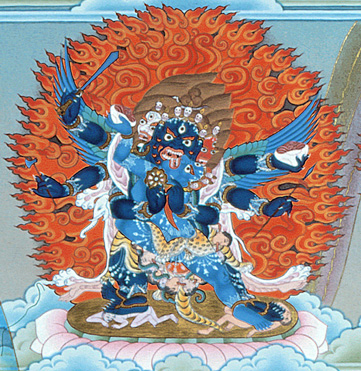Yamantaka: Difference between revisions
Jump to navigation
Jump to search
mNo edit summary |
No edit summary |
||
| Line 2: | Line 2: | ||
'''Yamantaka''' (Skt. ''Yamāntaka''; Tib. [[གཤིན་རྗེ་གཤེད་]], [[Wyl.]] ''gshin rje gshed'') — literally 'The Destroyer of [[Yama]], the Lord of Death', is a wrathful form of [[Manjushri]]. He also appears as one of the eight deities of [[Kagyé]] (see image) and is one of the [[four male gate keepers]] | '''Yamantaka''' (Skt. ''Yamāntaka''; Tib. [[གཤིན་རྗེ་གཤེད་]], [[Wyl.]] ''gshin rje gshed'') — literally 'The Destroyer of [[Yama]], the Lord of Death', is a wrathful form of [[Manjushri]]. He also appears as one of the eight deities of [[Kagyé]] (see image) and is one of the [[four male gate keepers]] | ||
==Empowerments Given to the Rigpa Sangha== | |||
*[[Trulshik Rinpoche]], [[Lerab Ling]], June 25th, 2003. ''<nowiki>'</nowiki>jam dpal tshe bdag yang zlog me'i spu gri'i sgrub thabs rnon po nad gcod kyi dbang dbang bka<nowiki>'</nowiki>'' from ''[[Döjo Bumzang]]''. "Razor of Fire", dark blue Yamantaka with three faces and six arms. This was practised by Nubchen Sangye Yeshe, who received it from Guru Rinpoche. Up to that point it was kama, but then it was hidden as a terma. | |||
[[Category:Buddhas and Deities]] | [[Category:Buddhas and Deities]] | ||
[[Category:Kagyé]] | [[Category:Kagyé]] | ||
/nowiki | |||
Revision as of 09:43, 16 April 2012

Yamantaka (Skt. Yamāntaka; Tib. གཤིན་རྗེ་གཤེད་, Wyl. gshin rje gshed) — literally 'The Destroyer of Yama, the Lord of Death', is a wrathful form of Manjushri. He also appears as one of the eight deities of Kagyé (see image) and is one of the four male gate keepers
Empowerments Given to the Rigpa Sangha
- Trulshik Rinpoche, Lerab Ling, June 25th, 2003. 'jam dpal tshe bdag yang zlog me'i spu gri'i sgrub thabs rnon po nad gcod kyi dbang dbang bka' from Döjo Bumzang. "Razor of Fire", dark blue Yamantaka with three faces and six arms. This was practised by Nubchen Sangye Yeshe, who received it from Guru Rinpoche. Up to that point it was kama, but then it was hidden as a terma.
/nowiki